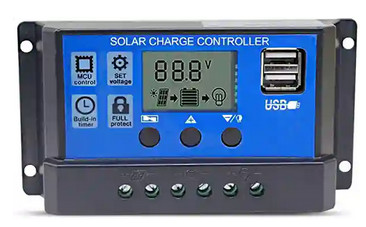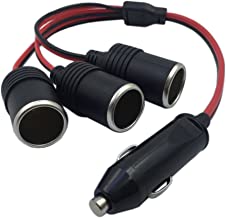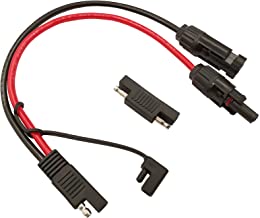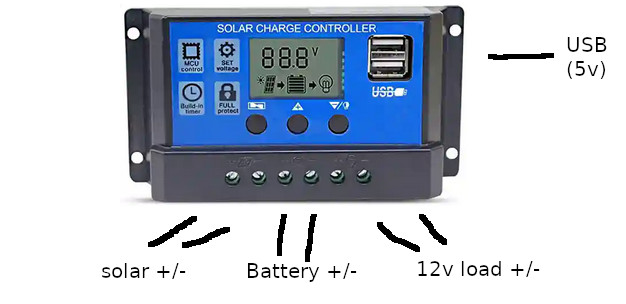Table of Contents
Note: this is a streamlining of the shallow cycling article.
Micropower for car-dwellers
People with minimal power needs (a few amps a night) may be able to get by using just a bit of charge off the vehicle's starter battery. It can be done for about $25, or about $100 with 100w of solar if one shops around.
the controller
 The core of the system is an inexpensive single-stage solar charge controller.1) No, solar is not required.
The core of the system is an inexpensive single-stage solar charge controller.1) No, solar is not required.
The 20A example pictured here was ~$15 at the time of writing. They are simple, generic devices sold under many names. The 10A versions are closer to $10.
This kind of controller is used because:
- it is cheap
- it is compact for ease of mounting in small spaces
- it can prevent draining the battery
- it has USB outlets
- it allow panels to be added if desired
wiring the controller
Here is how they are wired:
- the SOLAR terminals will be left empty if one has no panels. If you have panels those wires plug in here. A 20A controller has been selected so one could run up to 200w of 12v panels with this setup.
- the BATTERY terminals connect to whatever your battery is: starter battery for single-battery systems, the aux battery for dual-battery systems
- the LOAD terminals are where you take your 12v power from. This is critical because the controller can be configured to turn that circuit off at a predetermined voltage like 12.7v; this is called a Low Voltage Disconnect (LVD). Your starter battery cannot be drained when this feature is used properly.
- the USB output is also controlled by the LVD.
The hardest part of the installation will be running a wire from the battery to the controller. You may be able to leverage holes in the firewall2) for other wiring, or find other holes that are presently closed by rubber plugs.
using the 12v LOAD output
 One might use a $10 adapter like this one, cut off the single male plug and insert the wires into the LOAD terminals.3)
One might use a $10 adapter like this one, cut off the single male plug and insert the wires into the LOAD terminals.3)
Users with more complex power needs might wire a fuse panel to the LOAD terminals and from there to the various loads.
configuring the controller
There are three setpoints that need to be configured. Terminology will vary but basically:
- LOAD DISCONNECT - the voltage below which the LOAD terminal should be disconnected. 12.7v for example.
- LOAD CONNECT - the voltage at which LOAD terminal power is restored. The battery is assumed to have been charged again, so something like 13.4v is realistic.
- CHARGING VOLTAGE - the voltage you want the controller to hold when solar panels are present. When no solar is present this has no effect. With solar, one might set it to the the same voltage your alternator makes (probably around 14v – check with a multimeter). We know this voltage is safe for the battery because the car already charges the battery at that voltage. A more conservative value would be something like 13.6v which is roughly what battery “maintainers” or “trickle chargers” put out.
Here is an overview of the controller on youtube. The configuration begins at 11:35. He refers to the charging voltage as “float voltage” although the distinction is not important; there is only one charge stage. For reference, in the video the controller's setpoints are CHARGING VOLTAGE 13.7v, the LOAD CONNECT 12.6v, and the LOAD DISCONNECT 10.7v. Refer to the list above for settings more appropriate for your starter battery.
adding solar
Insert the panel wires into the SOLAR terminals and enjoy the life upgrade. ![]()
 For portable panels where you will be plugging/unplugging a lot a quick-disconnect of some kind would be useful. A common solution is to use an MC4-to-SAE adapter on the panel side and a short SAE connector on the controller side. Those willing to drill can install a port to allow plugging in the panel into the body of the vehicle instead of running wires through a window.
For portable panels where you will be plugging/unplugging a lot a quick-disconnect of some kind would be useful. A common solution is to use an MC4-to-SAE adapter on the panel side and a short SAE connector on the controller side. Those willing to drill can install a port to allow plugging in the panel into the body of the vehicle instead of running wires through a window.
One can also buy a set of MC4 extension wires4) which are wired it into the controller. This provides the disconnect and will also allow you to deploy portable panels in the sun while the vehicle remains in the shade.
picking panels
This kind of controller will harvest more power when used with panels that have a lower Vmp / higher Imp rating. Luckily these are often found on lower-priced polycrystalline panels. Big box stores like Home Depot often have 100w panels for $80 or less. Watch for sales. Otherwise $100 for 100w shipped is common on sites like Amazon.
If you have the ability to mount “framed”5) panels on your vehicle I encourage you to do it; the panels will always be deployed and working with no effort from you.
If this is not an option you may want to deploy portable panels which are stored when not in use. Because of their light weight and storability (?) flex panels are often used as portables. They tend to cost about 2x as much as framed panels, do not last as long, and can difficult to prop up in breezes. DO NOT FLEX THEM or walk on them no matter what they are called.
using alternator power
You may want to install an isolator to pull more 12v power into the cabin while driving. This does not require an aux battery setup.
caveats
- If your battery has removable caps, check the water level more regularly and add distilled water as required.
- remember to leverage the power of the alternator when the vehicle is running: charge all your devices for “free”!
- the items shown above are examples rather than recommendations. Do your own research and buy stuff that meets your particular needs.


